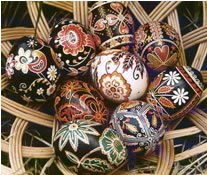 |
Pascha
pysanky |
For Christ, our paschal lamb, has been sacrificed. Let us therefore celebrate the festival ...
1 Corinthians 5:7
Pascha is the observance of Christ’s resurrection as celebrated in the Orthodox or Eastern Church; pronounced paska, it is a transliteration of a Greek word, which is itself a transliteration of the Hebrew pesach, meaning Passover.
In 325 CE a council of 300 bishops assembled in Nicea* (now Iznik, Turkey), one of the aims of which was to establish a date for the Christian Passover. In order to differentiate the church from Judaism, the bishops decreed that their Passover—later changed in Anglo-Saxon countries to Easter—would not be observed on the same day as the Passover of the Jews. Instead it was determined that the festival would fall on the first Sunday after the first full moon after the spring equinox—unless, that is, the Jewish Passover also fell on that day, in which case, Christians were to observe it on the following Sunday.
After the fall of the Roman Empire in 476 CE, differences in belief and practice arose between Christians in the East and the West, culminating in a division known as the “great schism”, when the patriarchs of the church in Constantinople and Rome were unable to resolve their differences. To honour historical chronology, Orthodox Christians decided that Easter should always fall after Passover, never before or on that day: the thinking was that as Jesus had observed the Jewish festival of Passover with his disciples the night before he was crucified, the Christian passover—i.e. Pascha—should occur after the Jewish observance. To keep to that tradition, the Orthodox Church continues to follow the Julian calendar.**
Traditionally, Orthodox Christians observe a strict fast for the 50 days prior to Pascha, abstaining from meat, dairy, fish, wine and oil. The service begins late on Saturday evening in total darkness: the priest emerges from the altar holding a single lit candle, and the congregation comes forward to light their own candles, after which the entire congregation proceeds outside, singing hymns and circling the building. After the procession has completed three circumambulations, the priest leads them back into the church, which is now brightly lit, signifying that Christ has risen from the dead. The faithful receive eggs that have been dyed red, the shell representing Christ’s tomb, and the red representing the blood he spilled for the salvation of humankind: the breaking open of these eggs symbolises the release of new life.
One traditional Pascha custom—the decorating of eggs—has a long history, especially in the Ukraine, where pysanky (singular pysanka, “thing that is written upon”) was a folk art form long before Christianity came to the region in approximately 998 CE. To the pre-Christian Ukrainians eggs symbolised the release of the earth from the shackles of winter and the coming of spring with its promises of new hope. It was believed that goodness would prevail over evil as long as humans continued to decorate pysanky. When Christianity came to the Ukraine, the designs which had previously symbolised the Pagan elements of air, fire and water were adapted as symbols of the Christian trinity of Father, Son and Holy Spirit.
*The
First Nicean Council was assembled by the Roman Emperor Constantine to
work out the details of the new state religion. While it was supposed
to have been made up of elders from five major Christian centers (Rome,
Athens, Alexandria, Jerusalem and Antioch), it also included elders of
all the major Pagan religions of Rome—it was Constantine’s
wish that all of the religions, then at odds with each other, would be
unified into one Catholic (‘universal’) church.
**Because it lacked an accurate vernal equinox, the Julian calendar was
replaced by the Gregorian calendar in the 16th century.